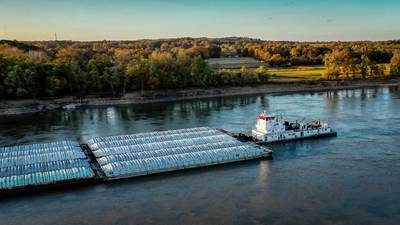Keeping the Inland Waterways Open: Balancing Maintenance and Operational Requirements
Inland waterways, sometimes called ‘nature’s superhighways’ provide a strategic advantage related to security, economics, and trade for any nation whose geography, topography, and climate enable this natural infrastructure. Economic benefits are realized in small rural areas through large urban communities that utilize the system for efficient transportation and improved markets. However, deliberate operational, resource, and policy efforts, along with broad stakeholder integration, are required to maintain and operate such a system. The United States boasts over 12,000 miles of inland and intracoastal waterways with 218 lock chambers at 176 sites. The U.S. system of barge navigation moves over 500 million tons of commodities annually. Combined with connectivity to coastal harbors and the Great Lakes, the inland waterways contribute substantially to national interests and are a key asset in the overall maritime transportation system.
Ensuring the resilience of the inland waterway system, while addressing near and long term maintenance needs, is an enduring challenge that requires vision and collaboration from industry, government, and academia. This panel has representation from all three of these stakeholder groups and will examine the past, current, and future challenges and opportunities of operating and leveraging the inland waterway system, along with the integral economic and international impacts.
- This is a synopsis of Jim Allen's panel to presented at Maritime Risk Symposium 2022: The Importance of Inland Systems to the MTS.
Keynote: “Strategic View of Inland Waterways”, Major General Diana M. Holland, Commander, U.S. Army Corps of Engineers (USACE), Mississippi Valley Division, Vicksburg, Miss.
Maintaining the inland system in a manner that balances navigation, recreation, flood management, environmental stewardship, and fiscal responsibility in the national interest falls within the mission space of the U.S. Army Corps of Engineers. The Mississippi Valley Division (MVD) has overarching responsibility to represent the best interest of the public as reflected in both law and policy as embedded in their mission statement to “serve the Mississippi Valley region by providing vital public engineering services and stewardship of water resource infrastructure, partnering in peace and war, to strengthen our nation’s security, energize the economy and reduce risks from disasters." The MVD is a full-spectrum and diverse work force of high quality, dedicated military and civilians including engineers, attorneys, architects, real estate appraisers, paramedics, rangers, geologists, biologists, surveyors, firefighters, foresters, hydrologists, public affairs specialists, wetland scientists, realty specialists, resource managers, and other professionals working daily to accomplish this mission.
“Past as Prologue”, Mr. John D. Cheek, Operations and Maintenance Engineer, USACE Inland Navigation and Design Center, Rock Island, Ill.
Navigation is the USACE earliest Civil Works mission, dating back to Federal laws in 1824 authorizing and funding USACE to improve safety on the Ohio and Mississippi Rivers and several ports. A brief review of this history until modern times provides context for the current and future challenges faced by inland navigation stakeholders. The Inland Navigation Design Center (INDC) provides engineering, design, analysis and review services for studies, new locks, new navigation dams, major rehabilitation of existing inland navigation locks and dams, and significant inland navigation lock and dam operations and maintenance projects. The INDC promotes quality design, and consistency in design and technical competency. The INDC collaborates with strategic international partners and provides national leadership for standardization of design, inspection, repair, and renewal of navigation infrastructure; investigates, recommends research and development needs, and implements new technologies as beneficial for life cycle cost reduction.
“Economic and International Trade Implications of the Inland Waterway System”, Mr. Guy H. Allen, Senior Economist, International Grains Program, Kansas State University, Manhattan, Kans.
Commerce and economic drivers make the inland waterway system the life blood of trade for many nations. For more than 35 years, the International Grains Program (IGP) Institute has established a worldwide reputation as a center of excellence for international programs related to flour milling and grain processing, feed manufacturing and grain management, grain marketing and risk management focused on corn, grain sorghum, soybeans and wheat. IGP’s mission is to provide technical, research-based training benefiting industry professionals globally and enhancing the market preference for U.S. grains and oilseeds. Examining current national and international trends and trials related to commodities that rely upon the maritime transportation system and the inland waterways will provide insight into the economic importance and impact of achieving a balance in maintaining and operating the network.
“Inland Waterway System Transportation Resilience and Future Opportunities”, Dr. Craig E. Philip, Vanderbilt University, Director, Vanderbilt Center for Transportation and Operational Resiliency (VECTOR), former President/CEO, Ingram Barge Company, Nashville, Tenn.
Transportation and operational resiliency are key considerations regarding the inland waterway system. Understanding the interconnectivity and interdependencies in a system-of-systems approach allows holistic risk management for infrastructure owners and maritime transport carriers. Resilience strategies to prevent and protect, withstand, respond, recover, and ultimately adapt to system stress and shocks is the objective of inland waterway stakeholders in industry, government, and academia. Collaborative efforts to more effectively integrate these aspects to enable rapid response and recovery that maintains and even improves operational capability and function of the inland waterway system and its many components and users with a ‘build back better’ approach will ensure the integrity and future capacity of this critical component of the maritime transportation system.
 About the Author: James (Jim) Allen is the Technical Director for Operational Science and Engineering (OSE) of the U.S. Army Engineer Research and Development Center’s Construction Engineering Research Laboratory (ERDC-CERL) in Champaign, IL. Jim holds a BS in Engineering from Texas A&M University, a Masters in Strategic Studies from the U.S. Army War College.
About the Author: James (Jim) Allen is the Technical Director for Operational Science and Engineering (OSE) of the U.S. Army Engineer Research and Development Center’s Construction Engineering Research Laboratory (ERDC-CERL) in Champaign, IL. Jim holds a BS in Engineering from Texas A&M University, a Masters in Strategic Studies from the U.S. Army War College.

















